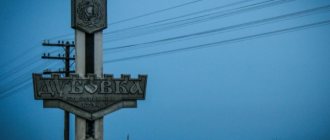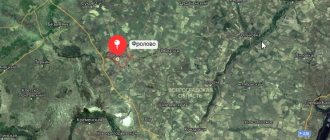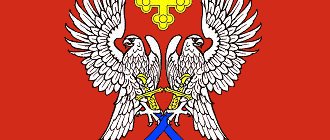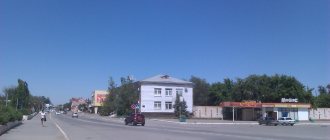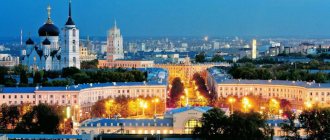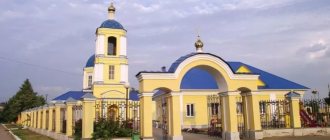Good day to all! Today I want to introduce you to the history of the city of Military Glory Kalach-on-Don, and invite you to take a tour of the city in which I was born and now live.
Where is the city of Kalach-on-Don located on the map? Kalach-on-Don is the administrative center of the Kalachevsky district, located in the southwestern part of the Volgograd region, 75 kilometers west of the city of Volgograd, in the bend of the Don River.
Places like the city of Kalach-on-Don are called provinces, or outback. What is the history of the city, how does it live and how does it develop? What are the attractions in Kalach-on-Don? You will learn about this and much more from my note.
Believe me, the steppe beauty of the Don region is no less interesting than the beauty of the lush subtropics and alpine mountains. Are you ready to travel? Then I will be very pleased to introduce you to the history and most interesting places of my city and its surroundings.
Everyone who comes to Kalach-on-Don in the summer is amazed by his green outfit. Old-timers remember what sandstorms (Kalachev residents jokingly call it “Kalachevsky rain”) hit the city in spring and summer, what snow drifts happened in winter.
Now around the city for many kilometers there is a continuous green ring of pine forest where you can meet mushroom pickers, hunters, and vacationers.
About the name and coat of arms of the city Kalach-on-Don
According to legend, the name of the Cossack farm, which stood on the site of the current city of Kalach-on-Don, was given by Peter the Great himself. Legend has it that the sovereign rested here when he was transporting ships built in the Voronezh region along the Don to Azov. Peter I liked the kalach that the locals treated him to so much that he wished that the farm would now be called Kalachevsky.
Of course, most likely this is nothing more than a legend. In fact, Kalach-on-Don, like its namesake Voronezh city, got its name from the nature of the surrounding area. Here Don makes a sharp bend, or, simply put, turns it into a roll. There is evidence in the dictionary. Confirmation of this can be found in V.I.’s explanatory dictionary. Dahl: one of the meanings of the word “kalach” is described as “a round channel, an outflow that flows into the same river; a sharp bend of a river around an island or peninsula.”
The city's coat of arms on a special edition coin.
However, the coat of arms of Kalach-on-Don depicts both a bread kalach and a “river” kalach: a stylized bend of the Don. This coat of arms was adopted in 2006, at the suggestion of a deputy of the city duma and, perhaps, the most amazing resident of Kalach, Alexander Rukosuev (about him - in the section about the local puppet theater “Magic Lantern”). This coat of arms was depicted on a commemorative 10-ruble coin from the “Cities of Military Glory” series - “Kalach-on-Don” (issued in 2015 with a circulation of 10 million copies). The author of the final version of the city’s coat of arms was the artist Vladislav Khlustov.
Map
| Kalach-on-Don: maps |
Kalach-on-Don: photo from space (Google Maps) Kalach-on-Don: photo from space (Microsoft Virtual Earth)
| Kalach-on-Don. Nearest cities. Distances in km. on the map (in brackets along roads) + direction. Using the hyperlink in the distance , you can get the route (information courtesy of the AutoTransInfo website) | |||
| 1 | New Rohachik | 38 (41) | IN |
| 2 | Surovikino | 51 (65) | Z |
| 3 | Settlement | 70 (87) | IN |
| 4 | Volgograd | 71 (80) | IN |
| 5 | Krasnoslobodsk | 75 (140) | IN |
| 6 | Ilovlya | 76 (165) | NE |
| 7 | Oblivskaya (Rostov region) | 77 (103) | Z |
| 8 | Kletskaya | 77 (163) | NW |
| 9 | October | 80 (185) | YU |
| 10 | Erzovka | 86 (113) | IN |
| 11 | Volzhsky | 91 (108) | IN |
| 12 | Svetly Yar | 94 (133) | IN |
| 13 | Srednyaya Akhtuba | 97 (105) | IN |
| 14 | Chernyshkovsky | 100 (101) | Z |
| 15 | Dubovka | 103 (133) | NE |
| 16 | Sovetskaya (Rostov region) | 109 () | Z |
| 17 | Serafimovich | 115 (189) | NW |
| 18 | Malye Derbets (Republic of Kalmykia) | 117 () | SE |
| 19 | Frolovo | 120 (225) | WITH |
| 20 | Kotelnikovo | 120 (234) | YU |
a brief description of
Located on the left bank of the Tsimlyansk Reservoir, 9 km above the entrance to the Volga-Don Canal named after Lenin, 85 km west of Volgograd. River port. Railway Donskaya station.
Territory (sq. km): 74
Information about the city of Kalach-on-Don on the Russian Wikipedia website
Historical sketch
It arose in 1708 as a Cossack settlement Kalach (Kalachevsky farm). The name comes from the popular geographical term kalach “a steep bend of a river around an island or peninsula” - this kalach existed at the farm before the formation of the Tsimlyansk reservoir.
In ATD-1945, the Kalach-on-Don farm. Since 1951, it has been a city, to which, to distinguish it from the city of the same name in the Voronezh region, an indication of its location on the Don was added.
During the Great Patriotic War, intense fighting took place in the Kalach-on-Don region in August 1942. On August 26, 1942, the city was captured by Nazi troops and liberated after stubborn fighting on November 23, 1942.
South-east of the city (in the area of the village of Sovetsky) a junction of troops of the South-Western and Stalingrad fronts took place, completing the encirclement of the Nazi troops at Stalingrad. The “Union of Fronts” monument was erected at this place (sculptor E.V. Vuchetich).
Economy
Factories: shipbuilding, ship repair, metal structures, JSC "Zhelezobeton", JSC "Alternativa" (furniture), "Donmoloko". Meat processing plant.
In the Kalachevsky district, wheat, barley, corn, rye, mustard, vegetables, and fruits are grown. They raise cattle, pigs, and sheep.
Culture, science, education
Puppet Theatre.
Museums, galleries, exhibition halls
Kalachevsky Museum of Local Lore 404507, Volgograd region, Kalachevsky district, Kalach-on-Don, lane. Voroshilova, 5 Phone(s): (8-272) 332-20 Website: https://vokm134.ru/
Architecture, sights
In the Kalach-on-Don area there is a monument “Union of Fronts” (sculptor E.V. Vuchetich).
| Population by year (thousands of inhabitants) | |||||||
| 1939 | 7.0 | 1996 | 25.0 | 2007 | 26.6 | 2015 | 25.1 |
| 1959 | 16.7 | 1998 | 25.3 | 2008 | 26.6 | 2016 | 24.7 |
| 1967 | 21 | 2000 | 25.4 | 2010 | 26.2 | 2017 | 24.2 |
| 1970 | 20.8 | 2001 | 25.3 | 2011 | 26.9 | 2018 | 23.9 |
| 1979 | 22.8 | 2003 | 26.9 | 2012 | 26.7 | 2019 | 23.8 |
| 1989 | 23.0 | 2005 | 26.6 | 2013 | 26.2 | 2020 | 23.6 |
| 1992 | 23.5 | 2006 | 26.6 | 2014 | 25.6 | 2021 | 23.5 |
About the history of the city
The year of foundation of the Kalachevsky farm is known precisely: 1708. This small Cossack settlement was part of the yurt of the village of Pyatiizbyanskaya of the Don Army. Nowadays, this village, on the contrary, is a small farm in the Kalachevsky district. Its natives were the heroic Cossack officers of the Denisov family, participants in all wars of the Russian Empire, including the Patriotic War of 1812. In the local church, the walls of which are still preserved, Stepan Razin was baptized.
The Kalachevsky farm remained a small Cossack settlement until 1862, when the Volga-Don Railway was built from Tsaritsyn to Kalach - the oldest currently operating railway in the Volgograd region. The population of the farm began to grow rapidly: thanks to the local railway station - on the branch that connected the Volga with the Don, its strategic importance grew disproportionately. According to 1897 data, there were 553 households and 2,319 residents; three steamship piers on the Don; post and telegraph.
Center of Kalach-on-Don, 1951: in front of the Volgo-Don cinema building there is a monument to Stalin.
During the civil war, Kalach played a big role in the defense of red Tsaritsyn. The city became the scene of bloody battles between the Red Army and the rebel Cossacks, changing hands at least eight times. Kalach also played a great role in the Battle of Stalingrad. On August 26, 1942 Kalach was occupied by the Nazis. After stubborn battles, on November 23, 1942, our troops liberated the city; on the same day, as part of Operation Uranus, a “cauldron” ring closed near Kalach, into which Paulus’s group fell.
In 1951, the village of Kalach was renamed Kalach-on-Don, and it was given the status of a city. This was directly related to the completion of one of the Soviet “constructions of the century” - the Volga-Don Shipping Canal named after V.I. Lenin (here is the last lock before connecting the canal with the Don). After the establishment of the title “City of Military Glory,” Kalach-on-Don became one of such Russian cities (according to Decree of the President of the Russian Federation dated March 25, 2010 No. 342).
Triumphal Arch at the end of the Volga-Don Canal: the “gate” to the Don.
The most significant military events associated with the city
The Battle of Stalingrad, one of the most difficult and bloody in the history of the Second World War. On July 17, 1942, the vanguard units of the 6th German Army entered into battle with units of the 62nd and 64th armies. The historic battle has begun. The initial plan of the Wehrmacht command was to encircle the Soviet troops in the big bend of the Don with enveloping blows, reach the Kalach area and then break through to Stalingrad.
Major General Kolpakchi gathered the main forces of his 62nd Army at the big bend of the Don and created a bridgehead in the Kalach area. Thus, the vital crossing of the Don was blocked 70 kilometers west of Stalingrad. The fortified “Don Loop” projected to the west like a balcony, framing the river from the north and south. By 20 July, with the German 6th Army regaining the ability to advance, General Paulus was faced with the need to first break through the Soviet defensive line around Kalach. Thus began the battle for Kalach, an interesting and very important operation for further events - in fact, the first act of the Battle of Stalingrad.
General Paulus built his attack on the Kalach bridgehead as a classic encirclement. He ordered the 14th Panzer Corps to advance in a wide arc in the south, and the 24th Panzer Corps, assigned to him from Hoth's Panzer Army, to carry out a similar maneuver in the north so that both corps would unite at Kalach. The 8th Infantry Corps covered the army's long flank in the north, while Seydlitz's 51st Corps led a frontal assault on Kalach between two panzer corps. The main burden of the battle on the big bend of the Don fell on two tank divisions - the 16th tank division of the 14th tank corps and the 24th tank division of the 24th tank corps. Motorized divisions covered the flanks. The 24th Panzer Division from East Prussia, under the command of Major General von Hauenschild, was ordered to cross the Chir and turn north along the Don to Kalach. It was opposed by large forces of the Soviet 64th Army, which at that time was commanded by Lieutenant General Chuikov.
The first attack of the Germans by two tank companies and parts of motorized infantry regiments was initially unsuccessful - they were unable to pass the minefields behind which the Red Army soldiers were dug in. But on July 25, the 24th renewed the onslaught and, this time, managed to knock the enemy out of well-prepared positions, capturing important heights west of the Solonaya River. The Soviet 229 and 214 rifle divisions, which literally bit into their positions, put up heroic resistance and deprived the Germans of the possibility of a sudden exit to the Don. However, the 26th German motorized infantry regiment made a hole in the enemy’s defenses on the Solonaya River. On the armor of light armored vehicles, the grenadiers rushed to the east. The breakthrough has come true. A motorized infantry regiment and one tank battalion hastened to the crossing of the Chir in the Nizhne-Chirskaya area. The lead units of the attackers reached the river and turned south towards the bridge. During the night street fighting, the Germans captured a large populated area, and before midnight they had a ford and a bridge over the Chir in their hands.
While German motorized infantry established a bridgehead on the eastern bank, tanks and armored personnel carriers advanced through the enemy-held forest to the bridge over the Don. By morning, they came to the banks of this huge river - fateful for the entire Operation Barbarossa. The 24th Panzer Division managed to capture the important bridge intact. However, it was not yet possible to carry out a throw across the river onto a narrow strip of land between the Don and Volga in the direction of Stalingrad. It was necessary first to destroy large Russian forces west of the river, and especially because the enemy had managed to concentrate two armies east of the Don, against which the tank units of the 6th Army themselves could not do anything. On August 6, the last stage of the battle for Kalach began. The assault tank group of the 24th Panzer Division under the command of Colonel Riebel advanced from the Chir bridgehead through the covering units of the 297th Infantry Division to the north, in the direction of Kalach. The target was 35 kilometers away.
Soviet soldiers fought desperately. They understood what was at stake: if the Germans broke through, all Soviet troops west of the river would be cut off, and the road to Stalingrad would be open. However, the "armoured fist" of the 24th fought its way through Soviet defensive lines and minefields, repulsed several Russian armored counterattacks, and led the division's infantry and other units through enemy lines that in many places had not yet been crushed. Column after column of units of the 24th German Panzer Division, growling engines and grinding tracks, rushed across the steppe and, as night fell, reached the dominant height 184, right in front of Kalach, in the rear of the Russians.
In the left wedge of enveloping flares, in the sector of the 14th German Tank Corps, the operation also developed according to schedule. The Westphalians from Lieutenant General Hube's 16th Panzer Division launched an attack on July 23 with four battle groups. A volunteer division from the Soviet 62nd Army put up fierce resistance. By the afternoon, a wide gap had formed in the Soviet defense lines. On July 24, the Germans reached the river area. Liska northwest of Kalach. They were separated from the target by only 20 kilometers. Meanwhile, units of the 60th and 3rd German Motorized Infantry Divisions, advancing from the northwest, moved between the 16th Panzer Division and the Don in a southerly direction. Here they had to fight extremely difficult battles with tank brigades and Soviet rifle divisions that had pulled up from the opposite side of the river across the bridges in Kalach and Rychovo. As a result, parts of both German assault groups fought in the rear of the Soviet troops defending the bridgehead. General Kolpakchi's divisions gradually began to find themselves in a cauldron. The Soviet command realized the danger and threw all the forces at its disposal against the northern wedge of German envelopment. A life-or-death battle broke out as the Russians fought with ferocious tenacity and at the same time had unexpectedly powerful armored units at their disposal.
The battle was fought 65 kilometers from the Volga. Strong tank units faced each other. Each side tried to bypass and cut off the other. The front line ceased to exist. Like destroyers and cruisers, the tanks maneuvered in the sandy ocean of the steppe, trying to reach more convenient firing positions, bypass the enemy, hiding in villages for several hours and even days, delivering swift strikes from there, turning back and pursuing the enemy. And while the tank units, like predators, tore each other with teeth and claws in the steppe grass, a fierce air battle was playing out in the cloudless sky above the Don. Each side sought to attack accumulations of enemy equipment and destroy columns of trucks with ammunition and fuel.
However, on August 8, the spearheads of the offensive of the 16th and 24th German tank divisions united in Kalach. The cauldron lid slammed shut. The ring was formed by the 14th and 24th German tank corps, as well as the 11th and 51st infantry corps. The cauldron included nine Soviet rifle divisions, two motorized and seven tank brigades. The Germans captured or destroyed a thousand tanks and other armored vehicles, in addition to 750 artillery pieces. Due to the stubborn resistance of the Soviet troops, it took the Germans another half a month to carry out operations to eliminate the enemy in the Kalach area, capture bridges and create bridgeheads on the other side of the Don for the attack on Stalingrad.
Lock No. 13 of the Volga-Don Shipping Canal
Lock No. 13 of the Lenin Volga-Don Shipping Canal is located a few kilometers from Kalach, near the village of Pyatimorsk. This is the last lock of the canal, after passing which ships coming from the Volga enter the Don River. At the entrance to the canal from the Don, beacons are installed at the ends of the enclosing dams. The five-kilometer-long earthen dams of the supply canal are lined with double rows of pyramidal poplars, which creates a large “water” alley, which is closed by gateway No. 13. The control buildings of gateway No. 13, like gateway No. 1, are made in the form of a magnificent triumphal arch, being the ceremonial “gate” to canal from the Don side.
Gateway No. 13.
The arch is decorated with bas-reliefs; There are inscriptions on it: “Glory to our great Motherland” - when approaching from gateway No. 12, and “Glory to the victorious Soviet army” (in memory of the fierce battles that took place here during the Battle of Stalingrad) - when approaching from the Don River.
Monument "Union of Fronts"
In 1953-1955, on the right bank of the outport of lock No. 13 of the Volga-Don Shipping Canal, the majestic monument “Union of Fronts” was erected. It is dedicated to the significant event of the Battle of Stalingrad - the historical meeting of units of the Southwestern and Stalingrad fronts, which took place on November 23, 1942 near Kalach. This connection completed the encirclement of the fascist group and became the beginning of its complete defeat.
The monument is located 12 kilometers from the historical junction of the fronts, as it was flooded by the Karpov Reservoir in the early 1950s, during the construction of the Volga-Don shipping canal. The author of the monument is the great sculptor, People's Artist of the USSR Evgeniy Vuchetich (he also headed the construction of the monument-ensemble "To the Heroes of the Battle of Stalingrad" on Mamayev Kurgan, was the author of the "Warrior-Liberator" in Berlin's Treptower Park, and the sculpture "Let's Beat Swords into Plowshares" near the building UN in New York, and many other outstanding works).
Monument "Union of Fronts".
The multidisciplinary 16-meter sculptural monument depicts four soldiers from different units at the moment of the ceremonial meeting of two fronts. This is a motorized rifleman, horse guardsman, infantryman and tankman. Behind them are the banners of the fronts. The monument is installed on an 11-meter-high embankment hill, formed from soil obtained by digging the bed of the Volga-Don Canal. A long staircase leads to the foot of the memorial, and large stone pedestals with inscriptions are installed on the sides of the monument. Next to the monument there is a Cyril and Methodius cross by sculptor Vyacheslav Klykov in memory of the fallen soldiers.
The monument was restored in the 2000s, the area around it is well-groomed and landscaped. Over the years since the war, this majestic memorial has been visited by a huge number of people from all over the Soviet Union. Many of them are to pay tribute to the memory of their relatives who laid down their lives in this Don steppe. After all, the victory came at a high price. Descendants of generals and marshals of the USSR - participants in the Battle of Stalingrad - have also been here many times. Busts of Zhukov, Chuikov, Vasilevsky, Rokossovsky, Vatutin, Rodimtsev and other commanders also stand here, on the Walk of Military Glory of Victory Park.
Military units and formations formed from the city population
The government message about the treacherous attack of Nazi Germany on the USSR, transmitted by radio at 12 o'clock in the afternoon on June 22, 1941, was heard by Soviet people in all corners of the country.
On the same day, many Kalacheevites came to the district military registration and enlistment office with applications for their voluntary enrollment in the ranks of the Red Army.
A housewife from Kalach, D. A. Soboleva, wrote in her statement: “... To protect my Motherland and provide assistance to soldiers ... I ask you to send me to the front as a nurse.”
“...I took part in the battles with the White Finns and now I want to defend my Motherland with my breasts from the attack of the fascists. Please don't refuse. Locksmith G. Kovalenko.”
“I ask you to send me to the front as a specialist and fighter. Paramedic P. Kolesnikov.”
Pioneer Petya Zavgorodny asked the editorial staff of the regional newspaper “Leninsky Put” to petition for him to be sent to the army: “I will honestly and boldly carry out the tasks of the commander. I have three defense badges. I’m already in my 11th year and I will help the fighters in any way I can.”
More than 20 thousand Kalacheevites left to fight the enemy.
On June 25, by order No. 1 of the district military commissar in the Kalacheevsky district, martial law was declared, squads and air defense services were formed. At the beginning of July, the organization of militia units began. On July 11, 1941, on the collective farm named after the OGPU, more than a hundred people joined the ranks of the people’s militia, on the collective farm “20 Years of October” - 87. On July 15, there were already several thousand militia in the area. On July 3, a whole train of Komsomol members was sent from Kalach to build defensive structures in the Smolensk direction. For about three months, schoolchildren dug trenches, anti-tank ditches, and built dugouts.
Stele Kalach-on-Don – City of Military Glory
This 12.5-meter monument was inaugurated in November 2017, on the 75th anniversary of the historical union of the fronts. The top of the stele is decorated with the Coat of Arms of the Russian Federation, the lower part of the monument is decorated with the text of the Presidential decree conferring the title “City of Military Glory” on Kalach-on-Don, and on the other side is the coat of arms of the city. Along with the governor, this monument was opened by veterans of the Great Patriotic War: 93-year-old Ivan Ivanovich Popov and 91-year-old Vasily Parfenovich Borodin (holder of two Orders of Glory, Honorary Resident of the city).
Stele Kalach-on-Don - City of Military Glory.
Location: Boulevard of the 300th anniversary of Kalach-on-Don, between Revolutsionnaya and Oktyabrskaya streets, not far from the monument to Soviet tank crews.
Monument to Soviet tank crews (T-34)
The monument to Soviet tank crews in Kalach-on-Don is a T-34/85 tank mounted on a pedestal. It is located in front of the three-story building of the local vocational school.
Monument to Soviet tank crews in Kalach-on-Don. Behind him is the building of SPTU No. 13.
Address: st. Oktyabrskaya, 271.
Employment
In the city of Kalach-on-Don there is a ship repair yard, a river port, a meat processing plant and a bakery. In addition, agriculture is widely developed in the settlement and its surroundings, which includes pig and sheep farming, as well as wheat, corn, barley, mustard, rye, fruits and vegetables.
All these enterprises provide vacancies to job seekers of different levels of education and professional skills. There is also a network of public catering and fast food establishments in the city, which provide employment for those interested in positions of various skill levels.
The first Soviet monument tank in history (T-70)
The pedestal with the T-70 tank was installed by soldiers of the 26th Tank Corps on the mass grave of their comrades, in which more than 240 tankers were buried. A meeting dedicated to the opening of the tank monument took place on December 12, 1942. The T-70 light tank was one of the combat vehicles directly involved in the battles of Operation Uranus. It was installed at the mass grave on December 8, 1942, by order of the commander of the 152nd tank battalion, Captain Gladchenko. In accordance with this order, the pompotech of the battalion, Bondarenko, allocated a combat vehicle that had preserved its appearance for the monument, from among those that could no longer be restored. This T-70 became the first tank-monument in the history of the Great Patriotic War. Both he and the pedestal have been preserved to this day in their original form.
An article in Komsomolskaya Pravda (January 1943) about this event.
Address: Fallen Fighters Square, 7a.
The heroic T-70 tank, a participant in the Battle of Stalingrad, in our days.
The city during the Second World War
The outbreak of war in June 1941 disrupted normal life.
The Kalacheevites greeted this ominous news with great indignation. In the afternoon, rallies were held at enterprises, institutions, collective farms and state farms.
For about three months, schoolchildren dug trenches, anti-tank ditches, and built dugouts.
This period is also characterized by the fact that labor discipline in the region sharply increased and organization increased.
Kalacheevites also felt the proximity of the front from the intense work of the railway station. Military trains with military equipment, ammunition, and fuel constantly arrived here. They quickly unloaded, and the troops moved towards the front line.
In just the two months preceding the Soviet offensive in December 1942, as many trains arrived at the station as had previously arrived in a year and a half.
In this harsh time, Kalach becomes a front-line town. In Kalach itself and in many villages of the region, military units and divisions, headquarters, departments and departments were stationed. Major military leaders and representatives of the Supreme Command came here.
On December 15-31, 1942, the headquarters of the Southwestern Front was stationed in Kalach. The front at that time was commanded by Colonel General Nikolai Fedorovich Vatutin, the chief of staff was Major General G.D. Stelmakh, member of the Military Council - Lieutenant General A.S. Zheltov. It was from Kalach that the offensive operation of the Soviet troops in the middle bend of the Don, launched with the aim of preventing Paulus’s army from leaving the encirclement at Stalingrad, was carried out. The offensive led to a major defeat for the enemy. From December 1942 to April 1943, on Karl Marx Street in house number 13 (now a kindergarten), the headquarters of the partisan movement of the Southwestern Front was located, headed by Colonel A.N. Asmolov.
A lot of information has been preserved about the period of occupation of Kalach, stored in the Volgograd regional archive. Eyewitness accounts of that time help to accurately imagine the full weight of the occupation that fell on the shoulders of the Kalachevo residents. In the surrounding villages, as well as in Kalach itself, the invaders created several concentration camps, which held mostly prisoners of war, but there were also civilians.
Abuse and murder of adults and children were widespread in Kalach. Usually the reason for execution was sabotage or resistance to the Nazis, but sometimes the conquerors were simply having fun.
In occupied Kalach, despite the cruelty of the Germans, not only the adult residents of the city resisted them, but also children. The short life of young Kalachevo residents Ivan Tsygankov, Pavel Koshelev, Yegor Pokrovsky and Mikhail Shesterenko is an example of the heroism of young people in their native land.
Square of Fallen Fighters and Park "Alley of Heroes"
As in Volgograd, the central square of Kalach-on-Don is called the Square of Fallen Fighters, and the Alley of Heroes leads to it. The scale, of course, is not so significant, but this memorial, dedicated to those who died in the Great Patriotic War, is no less majestic. More than 15 thousand natives of the Kalachevsky district fought on the war fronts, more than 9 thousand of them died. 17 soldiers received the title of Hero of the Soviet Union (8 of them posthumously). The main part of the memorial exhibition is the Eternal Flame.
Memorial sign-howitzer at the entrance to Kalach-on-Don
After Kalach was awarded the title of City of Military Glory, the idea was realized to supplement the stele with the name of the city, standing at the entrance, with a memorial sign demonstrating its new status. The initiative came from A.G. Rukosuev and his puppet theater “Magic Lantern”. Artists created a life-size model of an M-10 howitzer using cardboard and papier-mâché. Then, focusing on this model, the welders made mounting parts from metal, and welded them into a “real” howitzer.
A memorial sign-howitzer at the entrance to Kalach-on-Don.
Museum of Local Lore
The Kalachevsky Museum of Local Lore was officially opened in 1972, on the eve of the 30th anniversary of the liberation of Kalach-on-Don from fascist troops. But the collection of materials about the historical past of the city began much earlier. In 1965, the Museum Council was created under the city administration. In 1968, the house of merchant S.I. Kravchenko, built in 1890, was allocated to the future museum. From 1969 to 1972 this building was completely renovated.
Museum of Local Lore.
The museum has 7 exhibition halls, including an Art Gallery of local painters. The museum collection includes more than 10,000 items, including unique monuments of nature and history of the region. Thematic collections: paleontology, archeology, household items of the Don Cossacks of the late 19th and early 20th centuries, items from the period of the Great Patriotic War. Temporary ones are dedicated to the works of local artists and craftsmen.
Museum opening hours. Monday-Friday: from 9:00 to 18:00, lunch: from 13:00 to 14:00, weekends: Saturday and Sunday. Address: per. Voroshilova, 5.
Merits of the city's rear
On June 28, the district newspaper published an open letter from employees of the State Bank branch to the workers, employees and intelligentsia of the region, in which they called on everyone to work on the collective farm fields on weekends. And on the second day, June 29, 16 employees of the State Bank branch provided practical assistance to the Krasnaya Niva collective farm in weeding garden crops. In one day they weeded two hectares of potatoes. On this day, two thousand people from Kalach worked on the collective farm fields, including members of the labor collectives of MTS, the Zagotzerno base, and the railway station.
Residents of the area collected and sent parcels with food and warm clothes for the soldiers to the front. People gave away sheepskin coats, cotton jackets, felt boots, warm underwear, mittens, socks, girls embroidered pouches and handkerchiefs. A total of 3,733 parcels with a total weight of 21,331 kilograms were collected and sent to the front.
Among the first to contribute their savings to the Voronezh Collective Farmer tank column was Sidor Ivanovich Besedin. His family contributed 9 thousand rubles in cash. Flour milling teams - 25 thousand rubles, signalmen - 13 thousand.
The names of patriots from the village of Manino, Erast Fedorovich Kramarev and Marfa Ivanovna Beloglyadova, who donated 100 thousand rubles each, became known throughout the country. Later E.F. Kramarev contributed another 100 thousand rubles for the construction of a fighter aircraft.
As the front approached Kalach, a first aid station for wounded soldiers was set up in the district hospital. In the children's building on the street. Karl Marx, 15, a hospital was opened. At the beginning of the summer of 1942, many seriously wounded soldiers were admitted to the district hospital. For more than two days, doctor E.V. Fedorova and operating nurse V.Yu. Vasiliev provided them with surgical assistance. Part of the hospital premises was transferred to the hospital of the People's Commissariat of Health (NKH).
On July 8, 1942, an order was received to burn the archives and urgently evacuate the hospital. Patients undergoing treatment were discharged. The main equipment was loaded onto carts and transported along with the personnel across the Khoper River to the Alekseevsky district of the Stalingrad (Volgograd) region. The hospital building was completely occupied by the hospital. By the end of the summer, the front had stabilized, and on August 20 the hospital returned to Kalach. The years 1942-1943 were the most difficult in terms of the epidemiological situation. Among the civilian population, 13 cases of typhus, 125 of typhoid fever, 38 of dysentery, 28 of scarlet fever, and 165 of diphtheria were reported. This was facilitated by the fact that Kalach was a railway dead end, and there was a large movement of troops and population here.
During the war years, several hospitals were deployed in Kalach: evacuation hospitals No. 273, 1154, 2624, military hospital No. 148, infectious diseases hospital No. 2078, mobile field hospital No. 84, anti-epidemic detachment of the Southwestern Front.
The population of the region provided great assistance in organizing and equipping hospitals. When in November-December 1942 it was necessary to set up a hospital as soon as possible, the women collected the necessary things from the residents: dishes, linen, furniture. During a large accumulation of the wounded, a significant part of them were placed in the houses of collective farmers, workers and employees of the region. The command of the 3rd Guards Army sent a letter to the Voronezh Regional Party Committee, which said: “For the loving maternal care shown by the workers of the Kalacheevsky district during the quartering of wounded and sick soldiers of the Red Army in the territory of this region, for the assistance provided to wounded soldiers and commanders in providing housing, for assistance in supplying food, for cultural services and care for the wounded, for demonstrating high Soviet patriotism, the Military Council of the 3rd Guards Army thanks the workers of the Kalacheevsky district and awards them with a certificate.”
Church of St. Nicholas the Wonderworker
In tsarist times, in the Kalachevsky farm there was a large church (St. Nicholas the Wonderworker) and a monastery (from the beginning of the 19th century - for men, and at the end of the 19th - beginning of the 20th century it was converted into a women's one). St. Nicholas Church, where the parochial school operated, stood on the site of the current Philharmonic, and the monastery monastery - on the territory of the current water workers' hospital.
The Soviet government opened a club in the church building (the dome and bell tower were dismantled), and located a district hospital with 60 beds in the monastery premises. The hospital was completely destroyed during the Battle of Stalingrad, but the temple survived. Moreover, one of the powerful aerial bombs exploded very close to him: the edge of a crater with a 25-meter diameter passed 5-6 m from the church wall. However, the church burned down in 1946 due to a child’s prank with fire, and in 1947 the Volgo-Don cinema was built on its foundation.
Church of St. Nicholas the Wonderworker.
Construction of a new large city church began in October 1990. It lasted for many years. On February 14, 2008, the main dome was installed, in the same year a new iconostasis was erected, ornamental painting of the walls was done, and a fence was built around the church. On April 26, 2011, the temple was consecrated by Metropolitan Herman. In 2014, St. Nicholas Church was given the status of a cathedral. Kalachevskaya diocese.
Address: st. Revolutionary, 293.
Kalachevsky Philharmonic
The Kalachevsk City Philharmonic was organized in 1999, thanks to the enthusiasm of a small group of like-minded people - cultural workers. In 2007, the Philharmonic Society was given part of the building of the Volgo-Don cinema, and it got its own concert hall, as well as a mounted stage for performances in open areas. Significant funds were allocated by the administration for the purchase of musical instruments, lighting and sound equipment. The Philharmonic began to operate its own recording studio, where all arrangements for concerts are recorded.
Kalachevsky Philharmonic.
As a result, the Kalachevsk City Philharmonic Society became a developed cultural institution, atypical for a provincial town, working in various genres of musical, theatrical and choreographic art. Along with the main direction of its activity - organizing concert and creative events, the Philharmonic implements programs for teaching and training children in the field of musical and choreographic art. Children's and youth creative groups have been formed at the Philharmonic, many of whose graduates have continued their creative careers in regional centers, Moscow and St. Petersburg.
Address: st. Oktyabrskaya, 94b.
